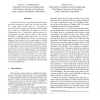4 search results - page 1 / 1 » The Fundamental Role of Hop Distance in IEEE802.11 Multi-Hop... |
ICNP
2005
IEEE
14 years 4 months ago
2005
IEEE
In wireless networks, it is well understood what throughput can be achieved by nodes who can hear each other (i.e. nodes within a single cell)[1, 3]. The effects of nodes beyond t...
ICDCS
2005
IEEE
14 years 4 months ago
2005
IEEE
— The shared-medium multi-hop nature of wireless ad hoc networks poses fundamental challenges to the design of an effective resource allocation algorithm to maximize spatial reus...
WCNC
2008
IEEE
14 years 5 months ago
2008
IEEE
Abstract—In ad hoc position-location networks, location information is obtained through the sequential estimation of node locations. An unlocalized node can estimate its location...
CORR
2010
Springer
13 years 11 months ago
2010
Springer
Opportunistic routing is a multi-hop routing scheme which allows for selection of the best immediately available relay. In blind opportunistic routing protocols, where transmitters...

